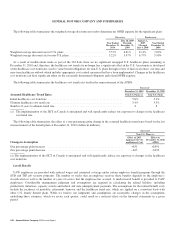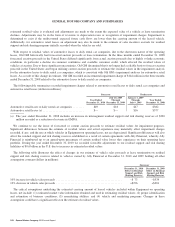General Motors 2010 Annual Report Download - page 111
Download and view the complete annual report
Please find page 111 of the 2010 General Motors annual report below. You can navigate through the pages in the report by either clicking on the pages listed below, or by using the keyword search tool below to find specific information within the annual report.GENERAL MOTORS COMPANY AND SUBSIDIARIES
Quantitative and Qualitative Disclosures About Market Risk
Automotive
We and Old GM entered into a variety of foreign currency exchange, interest rate and commodity forward contracts and options to
manage exposures arising from market risks resulting from changes in foreign currency exchange rates, interest rates and certain
commodity prices. We do not enter into derivative transactions for speculative purposes.
The overall financial risk management program is under the responsibility of the Risk Management Committee, which reviews and,
where appropriate, approves strategies to be pursued to mitigate these risks. The Risk Management Committee is comprised of
members of our Management and functions under the oversight of the Finance and Risk Committee, a committee of the Board of
Directors. The Finance and Risk Committee assists and guides the Board in its oversight of our financial and risk management
strategies. A risk management control framework is utilized to monitor the strategies, risks and related hedge positions, in accordance
with the policies and procedures approved by the Risk Management Committee.
In August 2010 we changed our risk management policy. Our prior policy was intended to reduce volatility of forecasted cash flows
primarily through the use of forward contracts and swaps. The intent of the new policy is primarily to protect against risk arising from
extreme adverse market movements on our key exposures and involves a shift to greater use of purchased options.
A discussion of our and Old GM’s accounting policies for derivative financial instruments is included in Note 4 to our consolidated
financial statements. Further information on our exposure to market risk is included in Note 21 to our consolidated financial
statements.
Old GM’s credit standing and liquidity position in the first half of 2009 and the Chapter 11 Proceedings severely limited its ability
to manage risks using derivative financial instruments as most derivative counterparties were unwilling to enter into transactions with
Old GM. Subsequent to the 363 Sale and through December 31, 2009, we were largely unable to enter forward contracts pending the
completion of negotiations with potential derivative counterparties. Since August 2010 we executed new agreements with
counterparties that enable us to enter into options, forward contracts and swaps.
The following analyses provide quantitative information regarding exposure to foreign currency exchange rate risk, interest rate
risk, commodity price risk and equity price risk. Sensitivity analysis is used to measure the potential loss in the fair value of financial
instruments with exposure to market risk. The models used assume instantaneous, parallel shifts in exchange rates, interest rate yield
curves and commodity prices. For options and other instruments with nonlinear returns, models appropriate to these types of
instruments are utilized to determine the effect of market shifts. There are certain shortcomings inherent in the sensitivity analyses
presented, primarily due to the assumption that interest rates and commodity prices change in a parallel fashion and that spot
exchange rates change instantaneously. In addition, the analyses are unable to reflect the complex market reactions that normally
would arise from the market shifts modeled and do not contemplate the effects of correlations between foreign currency pairs, or
offsetting long-short positions in currency pairs which may significantly reduce the potential loss in value.
Foreign Currency Exchange Rate Risk
We have and Old GM had foreign currency exposures related to buying, selling, and financing in currencies other than the
functional currencies of the operations. Derivative instruments, such as foreign currency forwards, swaps and options are used
primarily to hedge exposures with respect to forecasted revenues, costs and commitments denominated in foreign currencies. At
December 31, 2010 such contracts have remaining maturities of up to 12 months. At December 31, 2010 our three most significant
foreign currency exposures are the Euro/British Pound, U.S. Dollar/Korean Won, and Euro/Korean Won.
At December 31, 2010 and 2009 the net fair value liability of financial instruments with exposure to foreign currency risk was
$3.3 billion and $5.9 billion. This presentation utilizes a population of foreign currency exchange derivatives and foreign currency
denominated debt and excludes the offsetting effect of foreign currency cash, cash equivalents and other assets. The potential loss in
fair value for such financial instruments from a 10% adverse change in all quoted foreign currency exchange rates would be
$513 million and $941 million at December 31, 2010 and 2009.
General Motors Company 2010 Annual Report 109
























